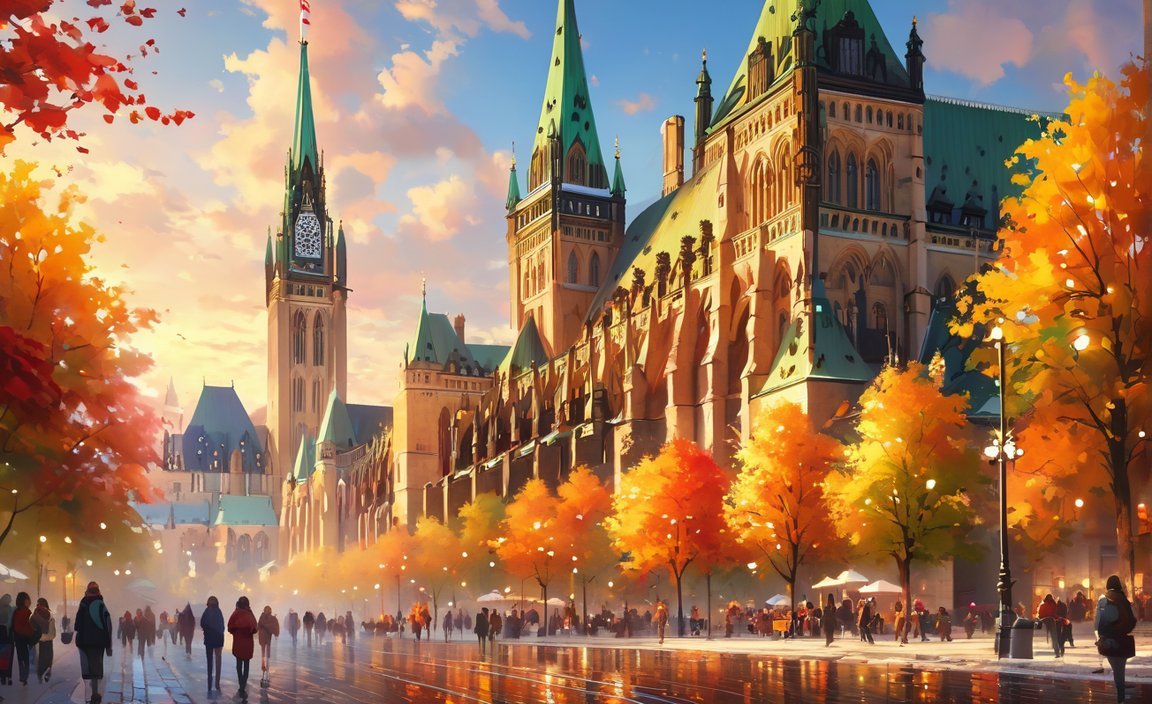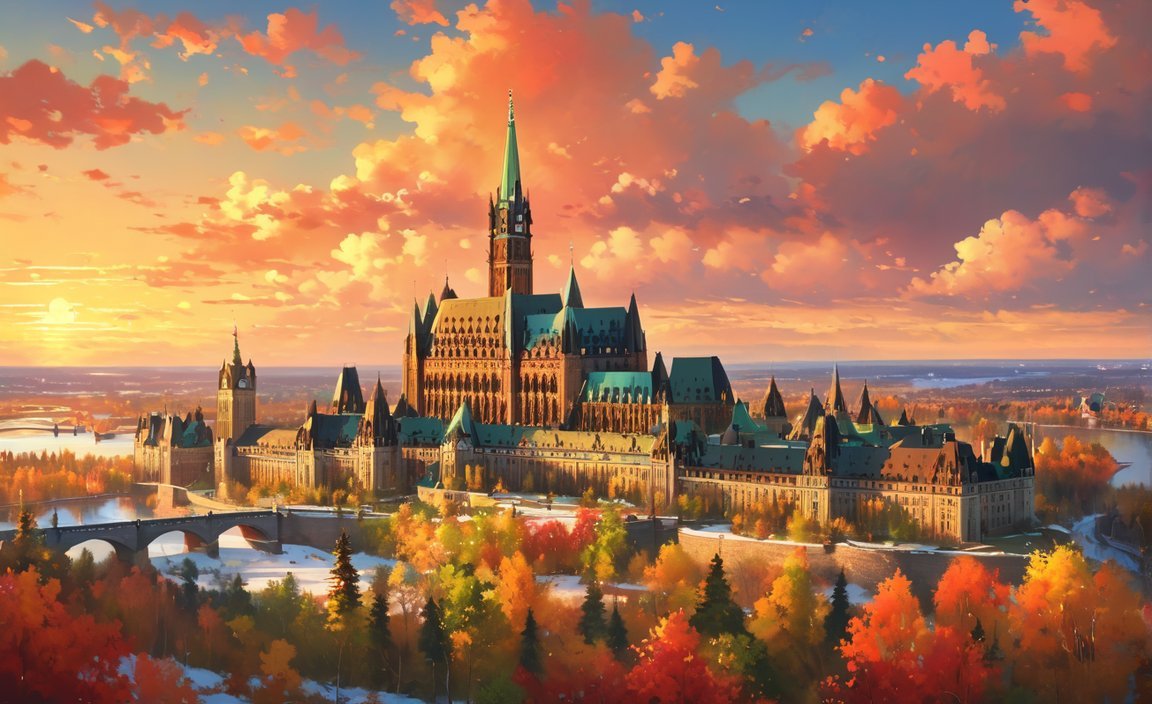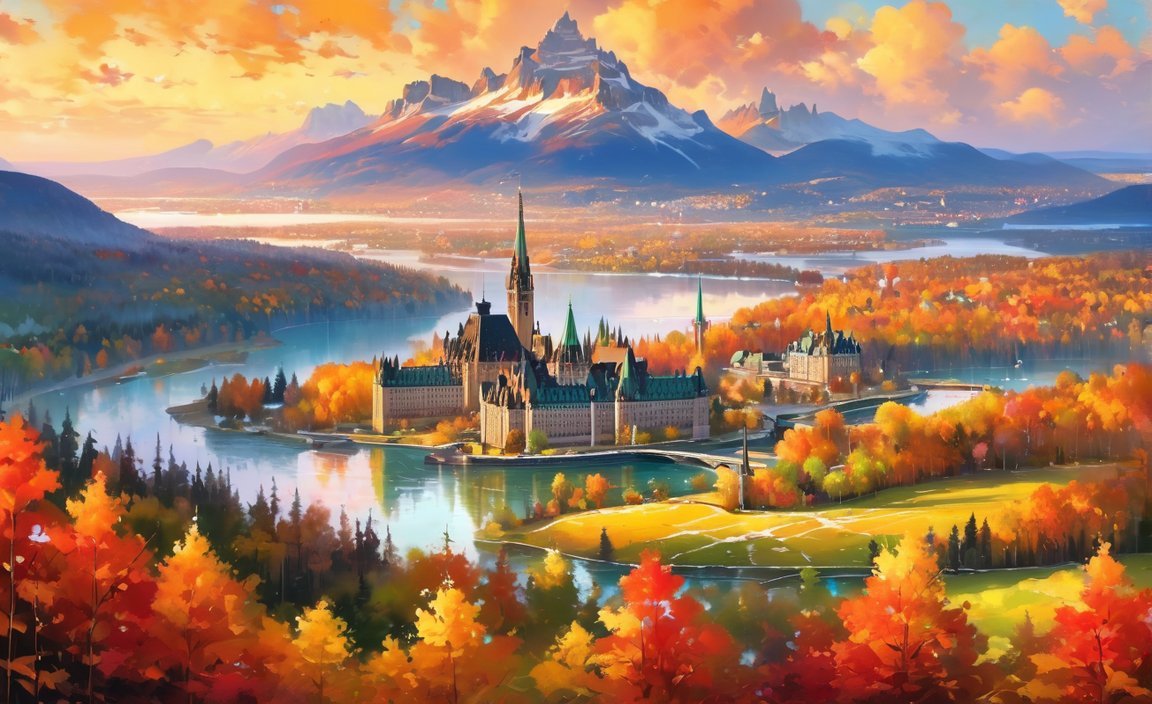Discover Ottawa: Unveiling 10 Fascinating Facts about the Historic Capital presents an insider’s guide to Ottawa’s most intriguing aspects. From its captivating multicultural tapestry to its iconic landmarks and vibrant local scene, this article takes you on an enthralling journey through the city’s past and present. As you delve into the ten captivating facts, you will gain a deeper appreciation for Ottawa’s rich heritage and the unique experiences it offers. So, let’s embark on this virtual exploration, discovering the hidden gems of this historic capital.
Key Takeaways:
- Queen Victoria of Britain chose Ottawa to be the capital of Canada in 1857.
- The name Ottawa comes from the Algonquin word adawe, meaning “to trade.”
- Ottawa is the seventh coldest capital in the world.
- In winter, the Rideau Canal in downtown Ottawa becomes the longest skating rink in the world, spanning 7.8 km.
- Ottawa has two official languages, English and French, making it the largest bilingual city in Canada.
- A quarter of Ottawans are outsiders.
- The Canadian Museum of History in Ottawa is the most visited museum in Canada, with over 1.2 million visitors annually.
- Ottawa is home to the largest per capita population of scientists, engineers, and PhD’s in Canada.
- Champlain’s astrolabe is displayed upside down on Nepean Point.
- To learn more about Ottawa, visit GEOS Ottawa and Fact City for additional information.
10 Facts About Ottawa

To truly understand the rich tapestry of Ottawa, Canada’s historic capital, let’s delve into ten fascinating facts that reveal the city’s vibrant multicultural scene, iconic landmarks, and intriguing past.
1. A Royal Capital
Did you know that Ottawa was chosen by Queen Victoria of Britain to be the capital of Canada in 1857? This regal stamp of approval has shaped the city’s prominence and historical significance. The decision to designate Ottawa as the capital has played a pivotal role in its development as a thriving cultural hub.
2. The Meaning Behind Ottawa
The name “Ottawa” originates from the Algonquin word “adawe,” which means “to trade.” This etymology reflects Ottawa’s rich history as a gathering place for diverse communities, fostering trade and cultural exchange.
3. On Ice
Ottawa takes the crown for being the seventh coldest capital in the world. Brace yourself for chilly temperatures, but fear not—the residents of Ottawa have embraced the frosty climate by transforming the Rideau Canal into the world’s longest skating rink, spanning a remarkable 7.8 kilometers, during winter months.
4. Bilingual Bliss
Ottawa proudly boasts both English and French as its official languages. As the largest bilingual city in Canada, visitors can immerse themselves in a multicultural and multilingual atmosphere that celebrates the country’s linguistic diversity.
5. Diverse Demographics
Ottawa’s unique charm lies in its diverse population. Approximately one-quarter of Ottawans hail from outside Canada, making the city a melting pot of cultures, customs, and perspectives. This diversity adds vibrancy and richness to Ottawa’s social fabric.
6. A Hub for Intellectual Powerhouses
Prepare to be impressed—Ottawa is home to the largest per capita population of scientists, engineers, and PhD holders in Canada. This concentration of intellectual prowess makes Ottawa a hotbed of innovation and a magnet for academia.
7. Upside Up at Nepean Point
Imagine stumbling upon a remarkable aeronautical anomaly when exploring Nepean Point—the astrolabe belonging to Samuel de Champlain, a French explorer and cartographer, appears to be upside down. This unconventional positioning invites contemplation of the mysteries and marvels of the universe.
8. A Must-Visit Museum
For culture enthusiasts, a visit to the Canadian Museum of History is a must. Situated in Ottawa, this renowned institution welcomes over 1.2 million visitors annually, making it the most visited museum in Canada. Prepare to be captivated by its captivating exhibits and historical treasures.
Now, armed with these captivating facts, you can embark on your journey to discover Ottawa’s rich heritage and vibrant local scene. Immerse yourself in the diverse cultural tapestry, explore iconic landmarks, and let the city’s history unfold before your eyes. Ottawa awaits you.
Additional Information Sources:
- GEOS Ottawa: [^1^]
- Fact City: [^2^]
Check out these fascinating 10 facts about Lake Superior. Discover interesting tidbits about the largest freshwater lake in the world. Learn more about this natural wonder by clicking here.
Discover 10 intriguing facts about Parliament House, the iconic political landmark. Uncover interesting details about this important institution by clicking here.
The Multicultural Fabric of Ottawa’s Neighborhoods
Ottawa, the historic capital of Canada, is a city brimming with cultural diversity and a vibrant multicultural scene. Its neighborhoods embody a rich tapestry of cultural influences that have shaped the city’s identity. From diverse communities to multicultural events, Ottawa is a melting pot of different ethnicities and backgrounds. In this article, we will delve into the multicultural fabric of Ottawa’s neighborhoods, uncovering fascinating facts that showcase the city’s cultural vibrancy.
Chinatown: A Gateway to Ottawa’s Asian Culture
Did you know?
– Ottawa’s Chinatown, located in Somerset Street West, is a vibrant neighborhood that offers a gateway to Asian culture in the city.
– The Chinatown Arch, also known as the Somerset Arch, is a prominent landmark, serving as a symbol of Ottawa’s multiculturalism.
– Visitors can explore a multitude of shops, restaurants, and cultural festivals that celebrate Asian heritage.
Chinatown in Ottawa is a thriving community that showcases the city’s diversity and cultural exchange. With a vibrant atmosphere and delicious cuisine, this neighborhood is a must-visit for anyone looking to immerse themselves in Ottawa’s multicultural tapestry.
Little Italy: A Slice of Mediterranean Charm
Did you know?
– Situated along Preston Street, Ottawa’s Little Italy is a neighborhood known for its European charm and Mediterranean influence.
– Visitors can indulge in an array of Italian culinary delights, from authentic pizza and pasta to gelato.
– The neighborhood hosts the annual Italian Week Festival, celebrating Italian culture through music, art, and culinary experiences.
Little Italy is a picturesque neighborhood that offers a taste of Italy in the heart of Ottawa. Whether you’re exploring the local shops or savoring traditional Italian dishes, this neighborhood provides a delightful escape to the Mediterranean.
The Glebe: Where Heritage Meets Diversity
Did you know?
– The Glebe, located just south of downtown Ottawa, is a neighborhood known for its historic homes, tree-lined streets, and eclectic blend of cultures.
– This neighborhood is home to Lansdowne Park, a major hub for entertainment, sports, and cultural events.
– Visitors can explore the farmer’s market, attend concerts, or cheer on the Ottawa Redblacks football team at TD Place Stadium.
The Glebe is a captivating neighborhood that seamlessly blends heritage charm with cultural diversity. With a range of activities and events, it offers a vibrant and inclusive atmosphere for residents and visitors alike.
Key Takeaways:
- Ottawa’s neighborhoods reflect the multicultural fabric of the city, showcasing its diverse communities and hosting various cultural events.
- Chinatown in Somerset Street West provides a gateway to Asian culture in Ottawa, with its iconic Chinatown Arch and a vibrant array of shops, eateries, and festivals.
- Little Italy along Preston Street offers a slice of Mediterranean charm, with its authentic Italian cuisine, gelato shops, and the annual Italian Week Festival.
- The Glebe, located south of downtown Ottawa, boasts historic homes, tree-lined streets, and a blend of cultures, with Lansdowne Park serving as a major hub for entertainment and events.
Sources:
– Discover Ottawa’s Cultural Diversity: A Guide to Multicultural Experiences
– 15 Captivating Facts About ByWard Market (Ottawa)
The Rideau Canal: A UNESCO World Heritage Site

The Rideau Canal holds a significant place in Ottawa’s history and continues to captivate visitors with its beauty and cultural importance. As a UNESCO World Heritage Site, it offers a rich tapestry of history and recreational opportunities that make it a must-visit destination. Let’s delve into ten fascinating facts about this iconic waterway.
1. A Historic Masterpiece
Constructed during the early 19th century, the Rideau Canal is a monumental engineering feat. Stretching across 202 km, it meanders through the Rideau and Cataraqui rivers, connecting Ottawa and Kingston Harbour on Lake Ontario. Its primary purpose was to serve as a secure supply route between Montreal and Kingston during the War of 1812.
2. UNESCO World Heritage Site
The Rideau Canal earned its place on the prestigious UNESCO World Heritage List in 2007. It was recognized for its outstanding cultural and recreational heritage values. By preserving this historic waterway, Ottawa showcases its commitment to safeguarding our past for future generations.
3. North America’s Oldest Continuously Operated Canal
As one of the oldest continuously operated canals in North America, the Rideau Canal holds immense historical significance. Its construction began in 1826 and was completed in 1832 under the guidance of Colonel John By of the British Royal Engineers. This engineering marvel stands as a testament to human ingenuity, resilience, and innovation.
4. A Journey Through Natural Landscapes
The Rideau Canal takes travelers on a picturesque journey through four distinct natural landscapes as they navigate from Ottawa to Kingston. From urban landscapes to rural countryside, lush wetlands to woodlands, this waterway offers a diverse and breathtaking experience for nature enthusiasts.
5. Lockstations and Water Level Changes
To facilitate navigation along the canal, there are 22 lockstations strategically placed along its route. These lockstations allow boats to traverse the various water level changes encountered along the way. These engineering marvels not only serve their purpose but also add to the charm and uniqueness of the canal.
6. A Recreation Haven
Beyond its historical significance, the Rideau Canal is known for its scenic beauty and serves as a hub of recreational activities. Boating, kayaking, and canoeing are popular ways to explore the canal’s tranquil waters. Visitors can immerse themselves in the surrounding natural beauty while enjoying an array of outdoor adventures.
7. Winter Wonderland
When winter embraces Ottawa, the Rideau Canal transforms into a magical wonderland. Freezing over, it becomes the world’s largest naturally frozen skating rink, stretching over 7.8 km. Every year, thousands of locals and tourists alike take to the ice, gliding along this unique skating rink, creating cherished memories.
8. Connecting Communities and Historical Sites
The Rideau Canal serves as a vital cultural and recreational link, connecting Ottawa with the communities it passes through. It provides opportunities for outdoor activities and connects visitors to historical sites along its route. Exploring the canal allows visitors to unravel the stories and heritage that have shaped the region.
9. Managed by Parks Canada
Ensuring the preservation and accessibility of the Rideau Canal, it is proudly managed by Parks Canada. They offer a range of visitor services, including guided tours, boat cruises, and the opportunity to experience navigating the canal’s lockstations firsthand. Parks Canada plays a crucial role in maintaining the integrity and heritage of this Canadian treasure.
10. A Voyage through Time
Embarking on a journey along the Rideau Canal is like taking a voyage through time. From its strategic military origins to its modern-day allure as a recreational haven, this waterway encompasses the essence of Ottawa’s past and present. Its significance resonates with all who visit, leaving them with a lasting appreciation for this historic gem.
Key Takeaways:
– The Rideau Canal is a UNESCO World Heritage Site, recognized for its cultural and recreational heritage values.
– It is one of North America’s oldest continuously operated canals, built between 1826 and 1832.
– The canal stretches across 202 km, connecting Ottawa and Kingston Harbour on Lake Ontario.
– Traveling along the canal offers a journey through diverse natural landscapes, showcasing the region’s beauty.
– Boating, kayaking, and canoeing are popular recreational activities along the canal.
– In winter, the frozen canal becomes the world’s largest skating rink, attracting visitors from near and far.
– The canal serves as a link between communities and historical sites, providing opportunities for exploration and connectivity.
– Managed by Parks Canada, the Rideau Canal offers various visitor services for an immersive experience.
– It represents the rich heritage of Ottawa, serving as a testament to human ingenuity and resilience.
– Exploring the Rideau Canal takes visitors on a voyage through time, uncovering the stories and significance behind this iconic waterway.
Sources:
– Rideau Canal – UNESCO World Heritage Centre
– A brief history of the Rideau Canal, a UNESCO World Heritage Site – Ottawa Tourism
The vibrant arts and music scene in Ottawa
Located in the heart of Canada, Ottawa not only boasts a rich history and stunning architecture but also offers a vibrant arts and music scene that captivates both locals and visitors alike. From urban art installations to world-class galleries, the city is a haven for artistic expression and cultural exploration. Let’s delve into ten fascinating facts about the vibrant arts and music scene in Ottawa.
1. Urban Art Extravaganza
Ottawa is teeming with urban art that adds a splash of creativity to its streets. With unique murals, colorful sculptures, intriguing miniatures, and thought-provoking graffiti, the city showcases a celebration of artistic expression on a grand scale [^1^]. Utilize the Ottawa Murals map and other online tools to embark on a self-guided tour of these awe-inspiring art installations [^1^].
2. Parliament Hill: The Epitome of Artistic Grandeur
As the most visited attraction in Ottawa, Parliament Hill is not only the seat of Canada’s federal government but also an icon of architectural brilliance [^2^]. The grand Gothic Revival buildings, adorned with intricate details and beautiful artwork, create a stunning backdrop for cultural events and celebrations [^2^].
3. National Gallery: A World of Art
The National Gallery of Canada showcases an extensive collection of Canadian and international art, making it a must-visit for art enthusiasts [^2^]. Immerse yourself in masterpieces by renowned artists, attend captivating exhibitions, and explore the gallery’s beautiful architecture that seamlessly blends with its natural surroundings [^2^].
4. Museums and Galleries Galore
Beyond the National Gallery, Ottawa is home to several other notable museums and galleries that cater to a variety of artistic interests. The Ottawa Art Gallery, the Canadian Museum of History, and the Canadian Museum of Nature are just a few of the cultural institutions that offer unique insights into the art and history of Canada and the world [^1^].
5. A Magnet for Artists and Galleries
The vibrant arts scene in Ottawa attracts talented artists and showcases their works in a multitude of galleries throughout the city. These galleries provide a platform for artists to exhibit their creations, ranging from paintings and sculptures to photography and mixed-media installations [^1^].
6. Marisa Gallemit: Embracing Cultural Identity Through Art
One of the notable artists in Ottawa is Marisa Gallemit. Her artwork reflects her Filipino-Canadian heritage and addresses themes of cultural identity and social justice [^1^]. Through her captivating creations, Gallemit contributes to the rich tapestry of Ottawa’s art scene and fosters meaningful conversations about diversity and equality.
7. Inspiring Outdoor Art Installations
In addition to traditional galleries, Ottawa embraces public art that can be found throughout the city. From captivating murals adorning buildings to striking sculptures dotted along pathways, the city showcases a diverse range of outdoor art that captivates and engages the community [^1^].
8. A Melting Pot of Artistic Influences
Ottawa’s arts and music scene is a melting pot of different cultures and influences. With a multicultural population and a city that celebrates diversity, Ottawa’s artistic landscape reflects the various backgrounds and experiences of its residents [^1^]. This fusion of artistic influences creates a vibrant and eclectic arts scene that is truly unique.
9. Art for All: Inclusive and Accessible
Ottawa’s arts and music scene is not limited to the elite; it is an inclusive space that welcomes people from all walks of life. The city’s commitment to accessibility ensures that everyone can enjoy and actively participate in the arts. Whether attending exhibitions, workshops, or live performances, there is something for everyone to appreciate and engage with [^1^].
10. Unleashing Creativity Through Festivals and Events
The vibrant arts and music scene in Ottawa truly comes alive during festivals and events that celebrate the city’s artistic spirit. From the Ottawa International Jazz Festival to Winterlude’s ice sculptures, these events provide platforms for artists to showcase their talents and for the community to come together and revel in the beauty of art and music.
Key Takeaways:
- Ottawa is adorned with urban art, including murals, sculptures, miniatures, and graffiti, creating a dynamic and visually stunning environment.
- The city is home to the iconic Parliament Hill, a symbol of artistic grandeur with its historic architecture and intricate artworks.
- The National Gallery of Canada houses an extensive collection of Canadian and international art, inviting visitors to immerse themselves in the world of creativity.
- Ottawa boasts numerous museums and galleries, such as the Ottawa Art Gallery, the Canadian Museum of History, and the Canadian Museum of Nature, offering diverse artistic experiences.
- The city’s vibrant arts scene attracts talented artists and showcases their works in a range of galleries, exhibiting various art forms.
- Marisa Gallemit is an artist in Ottawa whose creations reflect her Filipino-Canadian heritage and address themes of cultural identity and social justice.
- Outdoor art installations, including murals and sculptures, contribute to Ottawa’s artistic landscape, providing a captivating experience for the community.
- Ottawa’s arts and music scene is characterized by multicultural influences, reflecting the city’s diverse population and cultural fabric.
- The arts and music scene in Ottawa is inclusive and accessible, offering opportunities for everyone to engage and appreciate various art forms.
- Festivals and events, such as the Ottawa International Jazz Festival and Winterlude, showcase the vibrant arts and music scene, fostering creativity and community engagement.
Sources:
[^1^] Ottawa Tourism. “Ottawa’s vibrant urban arts scene.” Available: Accessed: Jun. 24, 2021.
[^2^] Ottawa Tourism. “Top 10 things to do in Ottawa.” Available: Accessed: Jun. 24, 2021.
FAQ
Q1: Why did Queen Victoria choose Ottawa to be the capital of Canada?
A1: Queen Victoria chose Ottawa to be the capital of Canada in 1857. It was selected for its strategic location between the provinces of Ontario and Quebec, as well as its potential to develop into a thriving urban center.
Q2: What is the significance of the Rideau Canal in Ottawa?
A2: The Rideau Canal in Ottawa is of great historical and cultural significance. It was primarily built as a strategic military route during the War of 1812 and is now recognized as a UNESCO World Heritage Site. The canal also serves as a popular recreational area and in winter, it transforms into the world’s largest skating rink.
Q3: How long is the skating rink formed by the Rideau Canal in winter?
A3: In winter, the Rideau Canal in downtown Ottawa becomes the longest skating rink in the world, spanning a distance of 7.8 kilometers.
Q4: Is Ottawa a bilingual city?
A4: Yes, Ottawa is the largest bilingual city in Canada with two official languages, English and French. This reflects the multicultural and diverse nature of the city.
Q5: Which museum attracts the most visitors annually in Canada?
A5: The Canadian Museum of History in Ottawa is the most visited museum in Canada, attracting over 1.2 million visitors per year. It offers a comprehensive collection that showcases the rich heritage and history of Canada.












